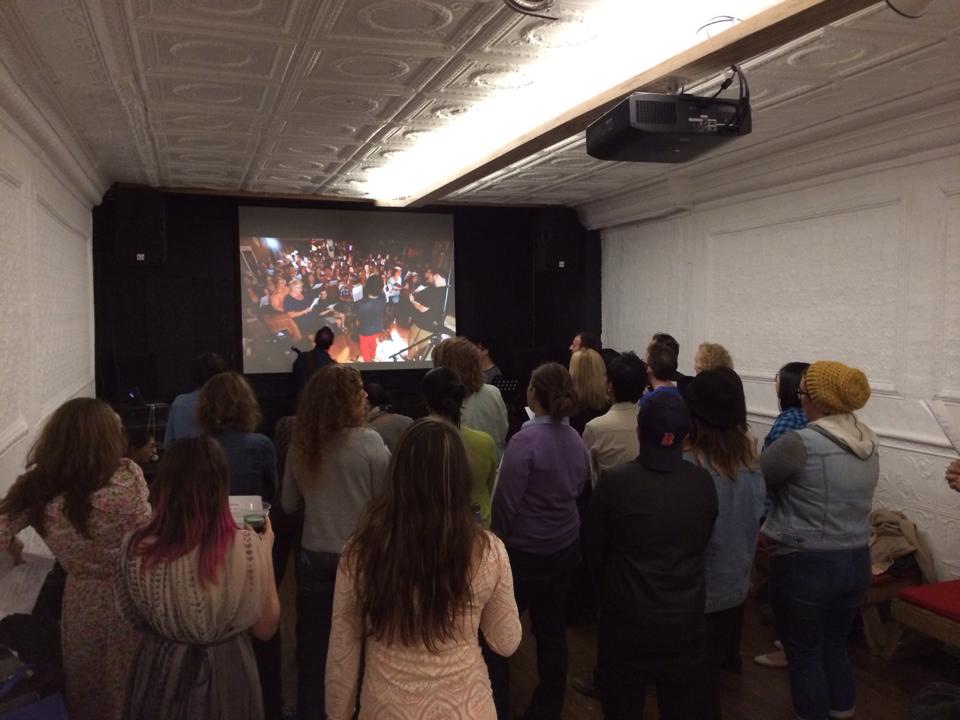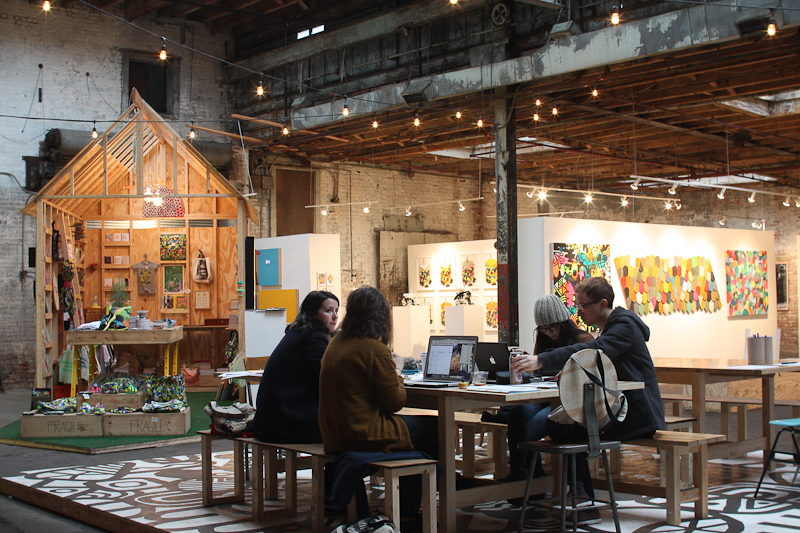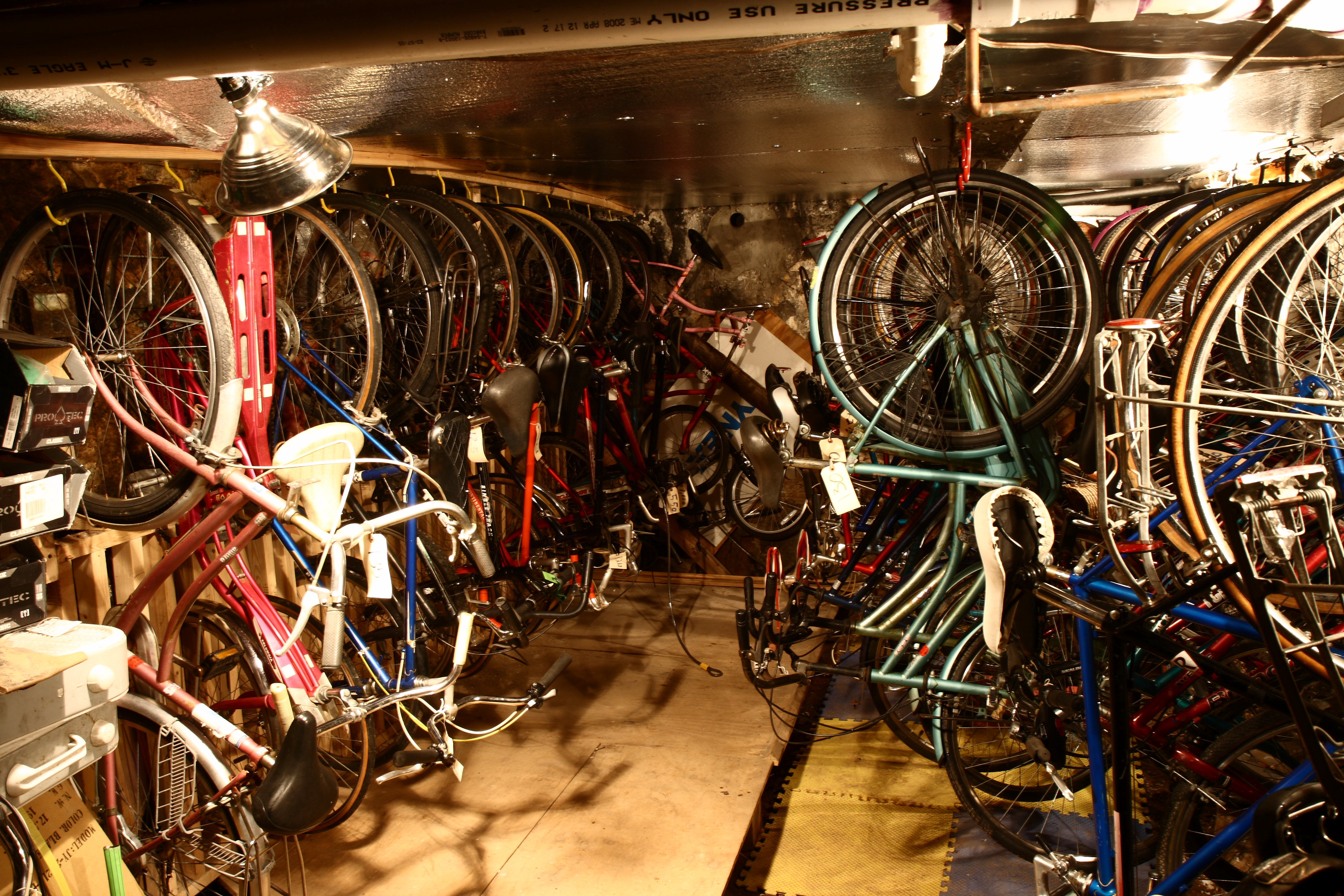uniondocs
space type: movies, event space, nonprofit | neighborhood: williamsburg | active since: 2005 | links: website, facebook, twitter
UnionDocs is a center focused on documentary art in all its facets. They put on about 100 events a year—primarily screenings, but also workshops, panels, radio-listening events, photography lectures, discussions, and more. These events have an “intensive” model, bringing together a gathering of people around a certain film, genre, topic, or theme, and are intended to encourage lively dialogue and critique. Some are collaborations; UnionDocs has worked with a wide variety of partners, from Harvard’s metaLab to the Northside Film Festival. And for those who can’t make the presentations, UnionDocs also engages critical writers to do essays and articles about the work they show.
Another big part of UnionDocs is the CoLAB, a collaborative studio fellowship program that brings together twelve artists per year, six from the United States and six international, to produce short documentary works around a specific theme. These films often go on to the festival circuit, and have been shown at the Tribeca Film Fest, BAM Cinemafest, Doc NYC, MoMA’s Doc Fortnight, and many more. At this point more than 70 media artists have come through the CoLAB program.
Finally there are longer-term productions, which come in different forms. The latest is a multi-year project called Living Los Sures, a “collaborative web documentary” about South Williamsburg. UnionDocs describes the project as “part omnibus film, part media archaeology, part deep-map and city symphony.” That project will be finished later in 2014, and there will be screenings, activities, and many other events to celebrate it.
Be sure to keep an eye out for that and all the other incredible work UnionDocs has to share—but first read my Q&A with Christopher Allen, UnionDocs founder.
brooklyn spaces: Give me a quick history of how this all got started.
Christopher: I actually moved into this building in 2002, and in 2003 a few close collaborators and I took it over and started turning it into an art collective. In 2005 we became a nonprofit, focusing primarily on the intersection of politics and art, which led us into documentary work. In 2007, most of the original people involved were heading in different directions, including myself, so we all moved out of the building and set up a sort of residency model. And then, a bit later, in 2009 I came back and make this my full-time venture with a proper staff.
brooklyn spaces: What would you say is the theme or mission statement of Uniodocs?
Christopher: We present and produce documentary art, and we’re interested in taking our audience on a journey through a variety of different subjects. We basically use documentary as a starting point to a broader conversation that can engage many different disciplines and areas of expertise, and hopefully get people excited and aware about things happening in the world.
brooklyn spaces: Tell me about a couple of your favorite UnionDocs events.
Christopher: Let’s see. Pretty early on we had an event with the artist Christo and the documentary legend Albert Maysles, which was incredible. It was a real surprise that we were able to get Christo here, and I think he liked it a lot. In 2007 we did an event with Laura Poitras; she’s an amazing filmmaker with an incredible vision, and she’s so tough and daring. Laura was the key person to break the Snowden story, so she’s a big inspiration for us. It’s amazing to be able to look back and say that before Laura Poitras was a global name, she was here talking with an audience of like forty people. One really different favorite event of mine was very recent, it was curated by our director of the CoLAB, Toby Lee, all around the idea of the “uncanny valley.” It was a series of films and lectures about things that appear to be real but are not, and what happens as they get closer and closer to being real. In addition to films, there was a performance by a master puppet artist and a talk by a scientist. It was a wide-ranging discussion that took people on a real intellectual journey. Our events are really geared toward a conversation, and often we have an audience that really shares and dives into deep questions with the filmmakers. There aren’t so many spaces where people can articulate their opinions in public in the flesh, so there’s something about that, that ritual, even if it seems anachronistic, that’s kind of a vital thing.
brooklyn spaces: I’d love to hear some more about the Southside documentary project Living Los Sures. What was the inspiration for that?
Christopher: It started four years ago, when we were given a disintegrating copy of this incredible documentary film that was shot in this neighborhood in 1984 by Diego Echeverria. What we’re doing is making the original film accessible to people in many different ways, like restoring and annotating it, and working with the community to mine it for other stories and populate it with other memories. A lot of the people in it are still in the neighborhood, and it’s great to look back at the work and try to understand it, and also to update it and challenge it and work with it in different ways. Diego has been very generous with us; he’s overjoyed that the film is being restored, that there’s a group of young artists who are re-engaging with the ideas in it. A whole set of short documentaries around the same ideas have come out of the CoLAB as well, like Toñita’s, which investigates one of the last remaining Puerto Rican social clubs in the neighborhood, along with a whole cast of characters there, including the matriarch of the club who’s been keeping it going all these years.
brooklyn spaces: UnionDocs clearly has a very involved and nuanced relationship with the neighborhood and community. Can you talk a little more about that?
Christopher: We’ve always tried to find ways to connect with the people in our neighborhood, but the Living Los Sures project has been really successful because we’ve been able to meet residents where they’re at; we’ve done screenings in church basements and schools and other community institutions. This project is a way for us to use our interests and talents to help preserve the legacy of this neighborhood, to create new relationships between neighbors, and to try to have a greater sense of place here. Lots of people think of the Southside as just a part of Williamsburg, but it has a very distinct history and population. This project is really devoted to celebrating it.
brooklyn spaces: It seems also like a really crucial cultural history. Are there other records to draw from? If people wanted to learn more about the history of this neighborhood, where would they go?
Christopher: There’s not that much that’s been written. A lot of organizations that are doing great work, they haven’t had a lot of time to document it because they’re out there making things happen. But there’s an effort toward cultural history now. The housing organization Los Sures HDFC is interested in starting a museum, and El Puente has been working on a sort of people’s history of the neighborhood. We’re trying to work with both of those organizations however we can.
brooklyn spaces: What are your thoughts on working and making art in this part of Brooklyn right now? Do you think the Southside is in danger of being overtaken by gentrification?
Christopher: I’ve always liked the energy here, it’s always felt very vibrant and exciting. The wave of new businesses and new residents is not stopping, but I don’t think the long-standing community will be pushed out in the same way that has happened in other places, largely because the community is organized, and many people own their property. I have a lot of hope for this area; the development is not all good, but it’s inclusive in some ways. If new residents can be open to the people who helped to preserve this neighborhood when it was bombed out and the landlords weren’t paying attention, then I think there’s a lot of positive things in the future for the Southside.
brooklyn spaces: What are your goals for the future of UnionDocs?
Christopher: We’re looking to continue to do exciting events that are cross-disciplinary and bring lots of voices into the conversation, and we’re trying to do more with the community we’ve brought together. I don’t think our vision is to become bigger and bigger and bigger; it’s more about improving the quality of what we’re already doing. But there’s also the possibility of taking the model we’ve established and doing it in other locations. There’s been a lot of interest from folks who have come through our collaborative program, especially the international folks; they go back to Turkey or Peru or Paris or Tijuana and want to do something like this where they’re from, so we’re thinking about how that could operate and what it would look like.
***
Like this? Read about more theatres: Spectacle Theatre, Bushwick Starr, Clockworks Puppet Studio, South Oxford Space, Cave of Archaic Remnants























